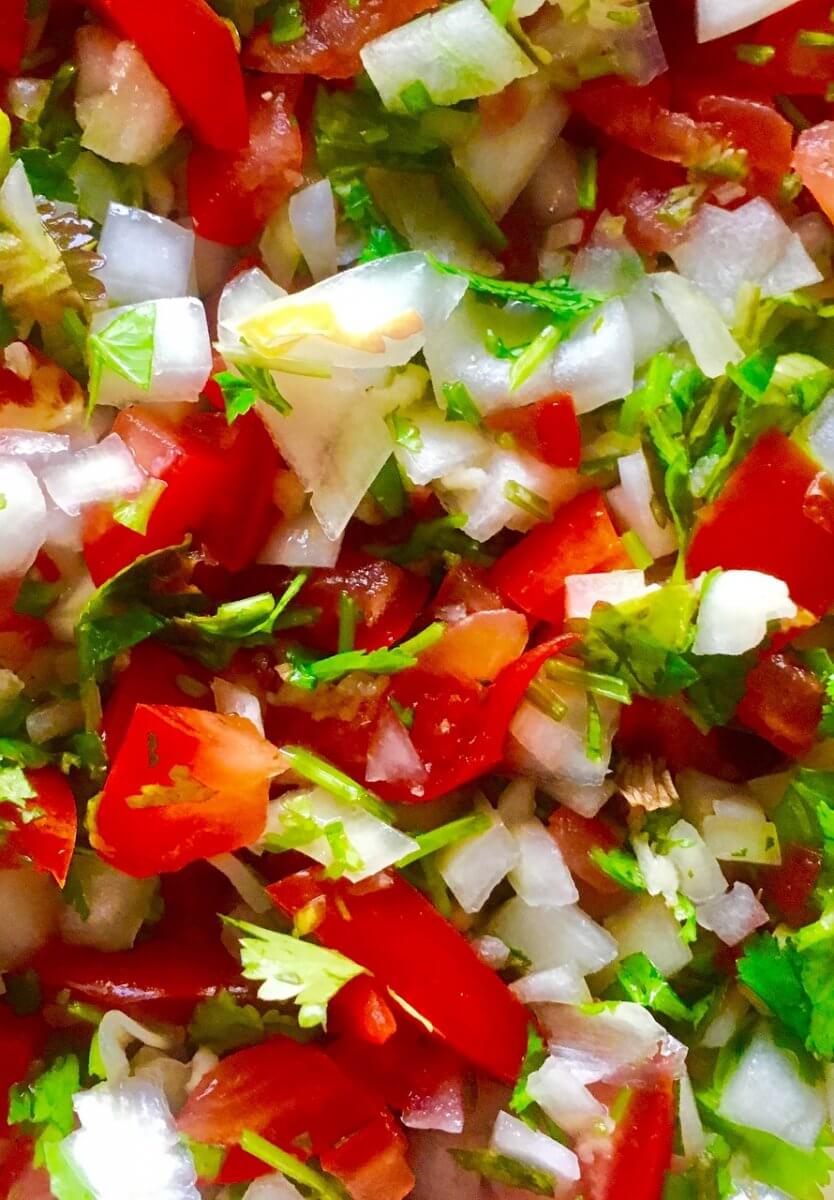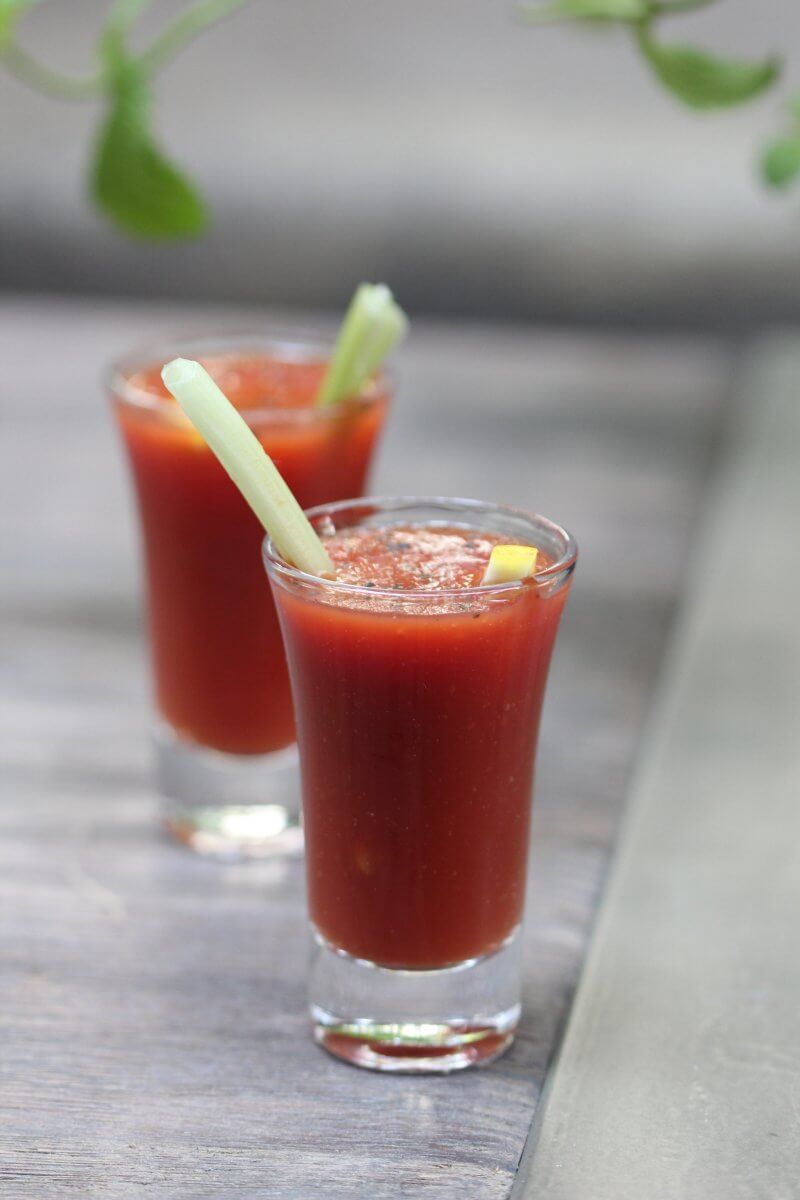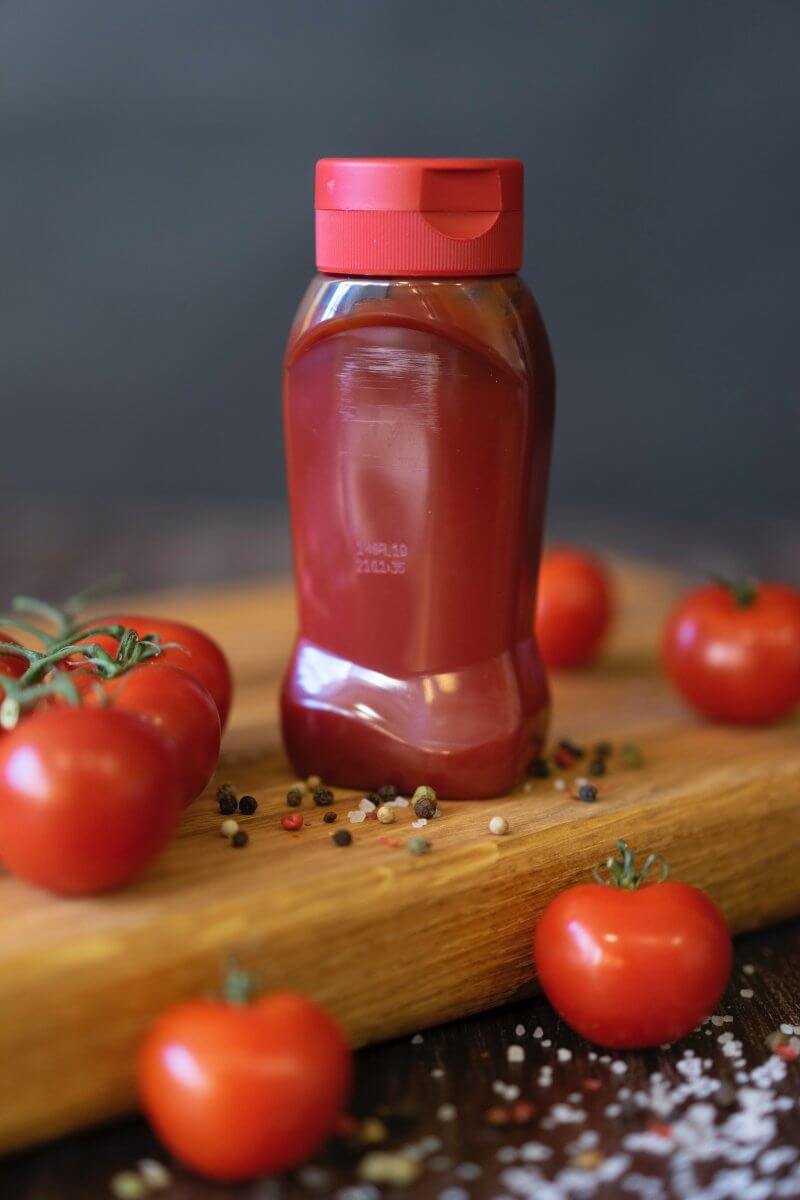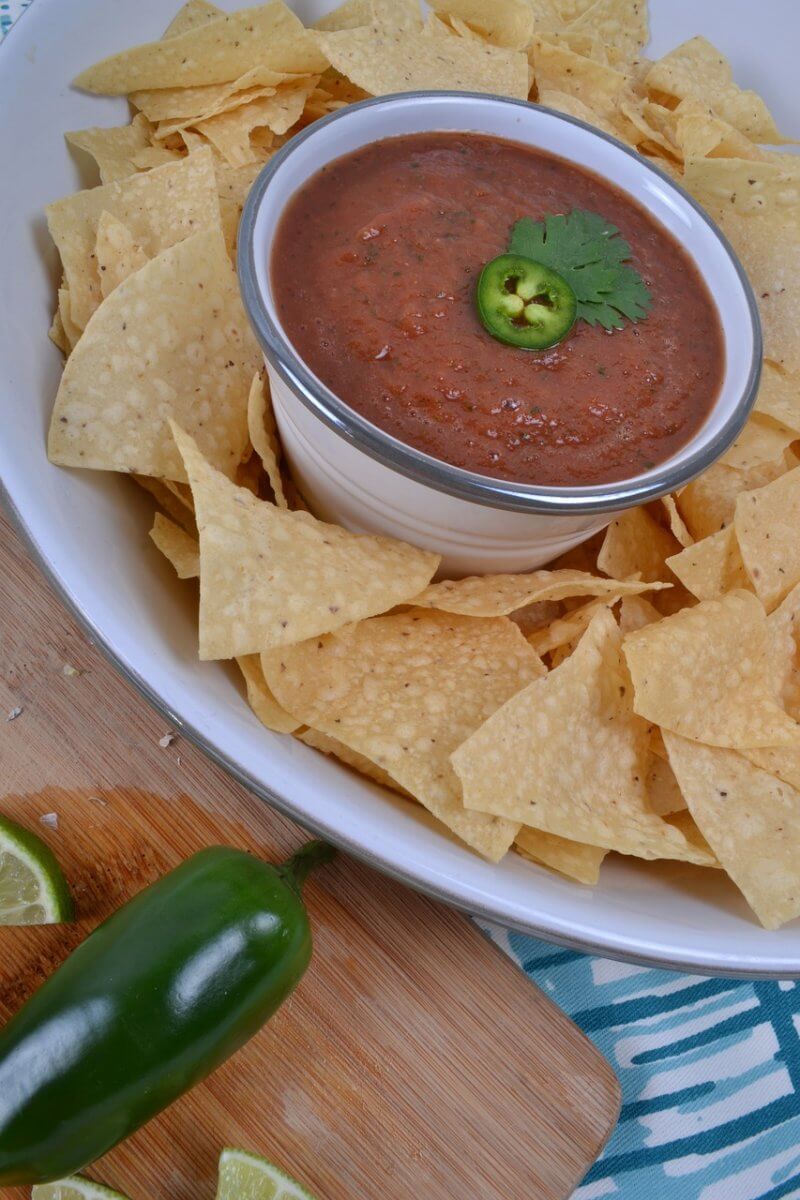What is the best Salsa substitute?
Are you looking for a salsa substitute? Salsa is the perfet side dish for tortillas, tacos, chicken, fish and meat. Or you can also use salsa in dips and toppings. But what can you use as a substitute whenever you run out of it? Try using Chopped tomatoes, Tomato Juice, Pasta Sauce, Ketchup, Hot Sauce, Picante Sauce, or Taco Sauce.
What is Salsa?
Salsa is a type of sauce or condiment that originated in Latin American cuisine, particularly in Mexico. It’s known for its bold and vibrant flavors, often combining various ingredients like tomatoes, onions, chili peppers, herbs, and spices. Salsa is used to add flavor, heat, and texture, and it can be served as a dip, topping, or accompaniment.
Traditional salsa typically consists of diced or chopped tomatoes, onions, chili peppers (hot ones such as jalapeños or serranos), cilantro, and lime juice. These ingredients are all combined together to create a flavorful mixture that can vary in spiciness, sweetness, and tanginess.
Salsas can come in many forms, including:
- Pico de Gallo: Also known as “salsa fresca” or “salsa cruda,” pico de gallo is a fresh salsa made with diced tomatoes, onions, cilantro, chili peppers, and lime juice. It’s often served as a topping for tacos, grilled meats, or tortilla chips.
- Salsa Roja: This is a cooked red salsa made from tomatoes that are roasted or boiled and then blended with chili peppers, onions, garlic, and other seasonings. It can vary in spiciness and is commonly used in cooking.
- Salsa Verde: A green salsa made from tomatillos, which are small green fruits with a slightly tart flavor. Salsa verde typically includes tomatillos, chili peppers, onions, and cilantro. It’s used in a variety of dishes and can be mild or spicy.
- Fruit Salsas: Some salsas incorporate fruits like mango, pineapple, or peach for a sweet and tangy twist. These fruit salsas can be served alongside savory dishes to add a contrast of flavors.
- Hot Sauce: While not always chunky like traditional salsas, hot sauces are often considered a type of salsa due to their similar use as a condiment for adding heat and flavor to foods.
Salsa can be enjoyed in many ways, such as a dip for tortilla chips, a topping for tacos, burritos, grilled meats, or seafood, and even as a versatile ingredient in cooking. Its popularity has spread well beyond Latin American cuisine, and you can find various interpretations and regional variations of salsa around the world.
Okay, before we look at your salsa substitute options, let’s deal with that empty cupboard situation!
Where can I buy Salsa?
If you want to be more prepared and ensure you don’t run out of salsa, then you should stock up now.
Nowadays most delicatessens and general supermarkets stock a wide variety of salsa. Or if you prefer you can also purchase salsa on-line.
So why not jump on and place your order today.
STOCK UP NOW!
This salsa is made from the finest tomatoes, onions, and jalapeno peppers, and it has only 10 calories per serving!
This is the chunky version but you can aways blend it to your liking. Also try adding chopped chillis if you like it spicy!
What can I substitute for Salsa?
Here are some of the best ingredients to substitute the flavor and role that salsa provides in your recipes.
- Chopped tomatoes
- Tomato Juice
- Pasta Sauce
- Ketchup
- Hot Sauce
- Picante Sauce
- Taco Sauce
Salsa substitutes
Chopped tomatoes as a Salsa substitute
Chopped tomatoes can be a great base for creating a simple salsa-like mixture. While it might not have all the components of traditional salsa, you can enhance the flavor and create a tasty topping or dip with a few additional ingredients. Here’s how you can use chopped tomatoes as a substitute for salsa:
Ingredients:
- Chopped tomatoes (fresh or canned)
- Onion (red or white), finely chopped
- Fresh cilantro, chopped
- Lime juice
- Salt and pepper
- Optional: diced chili peppers (such as jalapeños), garlic, and cumin for added flavor and heat
Instructions:
- Prepare the Tomatoes: Start by chopping fresh tomatoes into small pieces. If using canned tomatoes, drain them before chopping. You can use as many tomatoes as you like, depending on the amount of salsa you want to make.
- Add Onion: Finely chop an onion, either red or white, to add crunch and flavor to the salsa. You can adjust the amount of onion based on your preference.
- Add Fresh Cilantro: Chop a handful of fresh cilantro leaves and stems. Cilantro adds a fresh and herbaceous element to the salsa.
- Incorporate Chili Peppers (Optional): If you want to add heat, consider adding finely diced chili peppers like jalapeños. Adjust the amount based on your desired level of spiciness.
- Season with Lime Juice: Squeeze fresh lime juice over the mixture to add tanginess. Lime juice not only adds flavor but also helps balance the flavors of the salsa.
- Season with Salt and Pepper: Add a pinch of salt and a dash of black pepper to enhance the flavors. Taste as you go and adjust the seasoning to your preference.
- Optional Flavor Enhancements: If you have garlic or ground cumin available, you can add a small amount to the mixture. This will enhance the flavor profile.
- Mix Well: Gently toss all the ingredients together to ensure they are well combined.
- Let it Rest: Allow the mixture to sit for a little while, ideally 15-30 minutes, to allow the flavors to meld together.
- Serve: Use your chopped tomato mixture as a dip for tortilla chips, a topping for grilled meats, or tacos. You can even have it as a side salad.
Remember that this chopped tomato mixture won’t have the exact consistency of traditional salsa, but it can still be a great addition to your meals. Feel free to adjust the ingredients based on your taste preferences and what you have available.

Tomato Juice as a Salsa substitute
Using tomato juice as a substitute for salsa will result in a thinner consistency than say chopped tomaotes. However you can still infuse it with flavors to create a salsa-like mixture. Here’s a simple way to use tomato juice as a base for a flavorful tomato-based dip or topping:
Ingredients:
- Tomato juice
- Onion (red or white), finely chopped
- Fresh cilantro, chopped
- Lime juice
- Salt and pepper
- Optional: diced chili peppers (such as jalapeños), garlic, and other seasonings
Instructions:
- Start with Tomato Juice: Pour the desired amount of tomato juice into a bowl. Keep in mind that tomato juice is thinner than chopped tomatoes, so you’ll want to work with the proportions accordingly.
- Add Onion: Finely chop an onion, either red or white, and add it to the tomato juice. Onions provide crunch and flavor to the mixture.
- Add Fresh Cilantro: Chop a handful of fresh cilantro leaves and stems and add them to the mixture. Cilantro adds freshness and herbaceous notes.
- Incorporate Chili Peppers (Optional): If you want to add heat, consider adding finely diced chili peppers like jalapeños. You can always adjust the amount based on your desired level of spiciness.
- Season with Lime Juice: Squeeze fresh lime juice into the mixture to add tanginess and brighten the flavors.
- Season with Salt and Pepper: Add a pinch of salt and a dash of black pepper to enhance the flavors. Taste and adjust the seasoning as needed.
- Optional Seasonings: If you have garlic, cumin, or other seasonings on hand, you can add them to the mixture to enhance the overall flavor.
- Mix Well: Gently stir all the ingredients together to ensure they are well combined.
- Let it Rest: Allow the mixture to sit for a little while, ideally 15-30 minutes, to allow the flavors to meld together.
- Serve: Use the tomato juice mixture as a dip for tortilla chips, a topping for grilled meats, or even as a chilled soup if the consistency is thin enough.
While this tomato juice mixture won’t have the same texture as traditional salsa, it can still provide a tasty and refreshing flavor to your dishes. Feel free to adjust the ingredients and quantities to suit your preferences.

Pasta Sauce as a Salsa substitute
Using pasta sauce as a substitute for salsa can work well in certain dishes, especially when you want to add a tomato-based flavor to your food. However, keep in mind that pasta sauce typically has additional seasonings and ingredients that might not align perfectly with the traditional flavors of salsa. Here are some ways you can use pasta sauce as a salsa substitute:
As a Topping for Mexican-Inspired Dishes:
- Tacos: Use pasta sauce as a topping for tacos along with your other favorite taco fillings.
- Quesadillas: Spread a thin layer of pasta sauce inside your quesadillas before cooking for added flavor.
- Burritos: Add pasta sauce to your burrito filling for a tomato-based kick.
- Enchiladas: Use pasta sauce as a base for the sauce in your enchilada recipe.
As a Dip for Tortilla Chips: Warm the pasta sauce slightly and serve it as a dip for tortilla chips. You can also add extra spices, chili flakes, or fresh ingredients like diced onions and cilantro to enhance the flavor.
As a Base for Casseroles or Bakes: If you’re making a Mexican-style casserole or bake, you can use pasta sauce as a base to add a tomato element to the dish.
In Breakfast Dishes: Use pasta sauce as a topping for breakfast burritos or breakfast tacos.
Pasta-Based Dishes: If the pasta sauce isn’t too heavily seasoned with Italian flavors, you might be able to incorporate it into dishes like pasta salads or pasta-based salads.
In Mexican-Italian Fusion Dishes: Get creative by combining elements of Mexican and Italian cuisines. For example, you could use pasta sauce as a base for a pizza topped with Mexican-style ingredients like black beans, corn, and jalapeños.
In Stuffed Peppers or Stuffed Tomatoes: Use pasta sauce as a filling or topping for stuffed peppers or tomatoes, incorporating a tomato-based flavor into the dish.
Remember that pasta sauce may have flavors that are different from traditional salsa, so taste as you go and consider adjusting seasonings as needed to achieve the desired flavor profile for your dish.

Ketchup as a Salsa substitute
Ketchup can be used as a substitute for salsa in certain dishes, although there are some key differences in flavor and texture. It is sweeter and less chunky than traditional salsa, but it can still provide a tangy tomato flavor to your dishes. Here are some ways you can use ketchup as a salsa substitute:
As a Dip for Tortilla Chips: Use ketchup as a simple dip for tortilla chips, especially if you’re in a pinch and don’t have salsa on hand. However, keep in mind that the sweetness of ketchup may affect the overall flavor.
In Breakfast Dishes: Use ketchup as a topping for breakfast burritos, breakfast tacos, or scrambled eggs with a Mexican-inspired twist.
Wraps or Sandwiches: Spread a thin layer of ketchup in wraps or sandwiches for a touch of tomato flavor, especially in dishes that could benefit from a slight sweetness.
In Casseroles or Bakes: Incorporate ketchup into Mexican-style casseroles or bakes as a tomato-based element.
In Meatloaf or Meatballs: If you’re making Mexican-style meatloaf or meatballs, you can use ketchup to add moisture and a tomato flavor to the mixture.
As a Base for Sauces: Use ketchup as a base for creating simple sauces by adding spices, herbs, and other ingredients to enhance the flavor and complement the sweetness.
In Fusion Dishes: Experiment with fusion dishes that combine elements of Mexican and other cuisines. For example, you could use ketchup in a Mexican-Asian fusion dish.
With Grilled Meats: Use ketchup as a dipping sauce or glaze for grilled meats, especially if you’re looking for a sweeter flavor.
When using ketchup as a salsa substitute, keep in mind that the sweetness of ketchup might alter the final taste of your dishes. You can try to balance it by adding additional spices, chili flakes, hot sauce, or other ingredients to achieve a more complex flavor profile. While ketchup might not provide the same texture and authenticity as salsa, it can still add a tomato-based element to your meals in a pinch.

Hot Sauce as a Salsa substitute
Using hot sauce as a substitute for salsa can add heat and flavor to your dishes, but it might lack the chunky texture and some of the other elements found in traditional salsa. However, if you enjoy spicy flavors, hot sauce can be a great addition to various dishes. Here are some ways you can use hot sauce as a salsa substitute:
As a Dip for Tortilla Chips: Use hot sauce as a dip for tortilla chips. Just keep in mind that hot sauce can be quite spicy, so start with a small amount and adjust to your preferred level of heat.
In Tacos, Burritos, and Quesadillas: Add a few drops or drizzle of hot sauce into your tacos, burritos, or quesadillas for an extra kick of heat and flavor.
As a Topping for Grilled Meats: Drizzle hot sauce over grilled chicken, steak, or other meats to add spice and depth of flavor.
In Sautéed Vegetables: Add a splash of hot sauce to sautéed vegetables to give them a spicy twist.
Eggs and Breakfast Dishes: Mix hot sauce into scrambled eggs or use it as a topping for breakfast burritos and omelets.
In Dips and Dressings: Incorporate hot sauce into creamy dips like sour cream or yogurt-based dips. You can also mix it into salad dressings for an extra kick.
In Soups and Stews: If you’re making a Mexican-inspired soup or stew, a touch of hot sauce can enhance the spiciness.
With Seafood: Hot sauce pairs well with seafood dishes. Try also using it as a dipping sauce for shrimp or fish tacos.
As a Marinade or Glaze: Create a marinade or glaze for grilled or baked dishes by mixing hot sauce with other ingredients like oil, lime juice, and herbs.
In Fusion Dishes: Experiment with fusion dishes that combine hot sauce with other cuisines for unique flavors.
When using hot sauce as a substitute for salsa, be aware of the spiciness level and adjust the quantity to your preference. Remember that hot sauces can vary widely in terms of heat and flavor profiles, so choose one that complements the dish you’re preparing. If you’re concerned about the lack of chunkiness, consider adding diced onions, tomatoes, or other ingredients to the dish to provide some texture.

Picante Sauce as a Salsa substitute
Picante sauce is already quite similar to salsa in terms of flavor and texture, so using it as a substitute for salsa is a straightforward choice. Here are several ways you can use picante sauce as a salsa substitute:
As a Dip for Tortilla Chips: Picante sauce is commonly used as a dip for tortilla chips, just like salsa. It provides a tangy and spicy flavor that pairs well with the crunch of the chips.
In Tacos, Burritos, and Enchiladas: Use picante sauce as a topping or filling for tacos, burritos, and enchiladas. It can add a zesty and flavorful element to these dishes.
With Quesadillas: Drizzle picante sauce inside quesadillas before cooking for an extra layer of flavor and heat.
As a Marinade or Cooking Sauce: Use picante sauce as a marinade for meats like chicken or steak. You can also use it as a cooking sauce for sautéing vegetables or adding flavor to stir-fries.
In Breakfast Dishes: Incorporate picante sauce into breakfast burritos, breakfast tacos, or omelets for a spicy twist.
As a Condiment: Use picante sauce as a condiment alongside grilled meats, sandwiches, and burgers.
In Casseroles and Bakes: Add picante sauce to casseroles, bakes, or one-pot dishes to infuse them with a flavorful and spicy kick.
With Seafood: Picante sauce can be used as a dipping sauce for seafood or as a topping for fish tacos.
As a Base for Sauces: Use picante sauce as a base to create sauces for pasta dishes, rice bowls, or other creative recipes.
In Mexican-Inspired Salads: Mix picante sauce into salads with beans, corn, and other Mexican-style ingredients for a tangy dressing.
When using picante sauce as a substitute for salsa, keep in mind that it might vary in terms of heat and spice level. Taste as you go and adjust the quantity based on your preference for spiciness. Since picante sauce is already similar to salsa, you can generally use it in the same ways you would use traditional salsa to add flavor, heat, and excitement to your dishes.

Taco Sauce as a Salsa substitute
Taco sauce is quite similar in flavor to salsa, but it often has a slightly thicker consistency. It may also include additional seasonings that are specific to taco seasoning. Here are some ways you can use taco sauce as a substitute for salsa:
As a Dip for Tortilla Chips: Taco sauce can be used as a dip for tortilla chips, providing a slightly different flavor profile with its taco seasoning.
In Tacos, Burritos, and Quesadillas: Use taco sauce as a topping or filling for tacos, burritos, and quesadillas. It complements Mexican-inspired dishes well.
With Nachos: Drizzle taco sauce over nachos, along with cheese and other toppings, for added flavor.
In Mexican-Inspired Casseroles: Incorporate taco sauce into casseroles, bakes, or one-pot dishes to infuse them with a taco flavor.
As a Topping for Grilled Meats: Use taco sauce as a topping for grilled chicken, steak, or other meats. This will add a tangy and seasoned element to your dish.
In Wraps or Sandwiches: Spread a thin layer of taco sauce inside wraps or sandwiches to add a taco-inspired twist.
As a Marinade: Use taco sauce as a marinade for meats like chicken or beef before grilling or baking.
In Breakfast Dishes: Mix taco sauce into scrambled eggs, breakfast burritos, or breakfast tacos for a flavorful kick.
In Mexican-Inspired Salads: Use taco sauce as a dressing for salads featuring Mexican-style ingredients like beans, corn, and avocado.
With Seafood: Use taco sauce as a dipping sauce for seafood or as a topping for fish tacos.
As a Base for Sauces: Mix taco sauce with other ingredients to create sauces for pasta dishes, rice bowls, or other creative recipes.
When using taco sauce as a substitute for salsa, consider the additional seasonings you are using as this may affect the overall flavor of your dish. You can generally use taco sauce in similar ways to salsa to enhance the taste of your Mexican-inspired meals.

FAQs
What is like salsa but not?
If you’re looking for something like salsa but with its own unique twist, you might want to try chimichurri! This vibrant sauce hails from Argentina and is a fantastic alternative. While salsa is usually tomato-based and often has a bit of a spicy kick, chimichurri is made from fresh parsley, garlic, vinegar, olive oil, and red pepper flakes. It’s more of a herby, tangy, and slightly spicy sauce that’s perfect for drizzling over grilled meats or even as a zesty dip for bread.
Another great option is pico de gallo, which is actually a type of salsa but has a chunkier, fresher texture with diced tomatoes, onions, cilantro, and lime juice. If you’re craving something a bit fruitier, mango salsa is a fun twist, combining sweet mango with red onion, bell pepper, cilantro, and lime juice.
For something completely different, consider tzatziki! This Greek sauce is made from yogurt, cucumber, garlic, and dill. It’s creamy, refreshing, and pairs beautifully with grilled veggies, meats, or as a dip for pita.
What is homemade salsa made of?
Homemade salsa is a burst of freshness in every bite! The classic version usually includes a few simple, vibrant ingredients including tomatoes, onions, cilantro, jalapeños, garlic, lime juice and a bit of salt and pepper to taste.
Chop everything up finely, mix it all together, and you’re good to go! Some people like to add a splash of olive oil for richness or a bit of sugar if the tomatoes aren’t sweet enough. And if you want to get fancy, you can throw in extras like bell peppers, avocados, or even some fresh corn.
Homemade salsa is super customizable and always a hit whether you’re dipping chips, topping tacos, or just eating it with a spoon (no judgment here!).
Summary for Salsa substitutes
Okay – that’s you all sorted with suitable substitutes for salsa.
So while there are various substitutes for salsa, each option offers its own unique flavor and texture. Here’s a summary of the substitutes mentioned and their potential uses:
- Chopped Tomatoes: Create a fresh and chunky texture similar to salsa by mixing chopped tomatoes with onions, cilantro, lime juice, and optional spices.
- Tomato Juice: Use tomato juice as a base for a thinner salsa alternative by adding onions, cilantro, lime juice, and optional seasonings.
- Pasta Sauce: Utilize pasta sauce as a substitute for salsa in Mexican-inspired dishes, wraps, casseroles, and more.
- Ketchup: While sweeter than salsa, ketchup can also be used in tacos, wraps, casseroles, and fusion dishes with other cuisines.
- Hot Sauce: Add heat and flavor to your dishes with hot sauce. You can use it as a dip, topping, or ingredient in various recipes.
- Picante Sauce: Easily use picante sauce as a salsa substitute due to its similar flavor and texture, in dips, tacos, burritos, and more.
- Taco Sauce: With a taco seasoning twist, taco sauce can also be used as toppings, marinades, or dips.
Remember that experimenting with these substitutes can lead to delicious and creative results. Adjust the quantities and combinations to match your personal taste preferences and the specific dishes you’re preparing. Whether you’re looking for a quick fix or aiming to add a unique twist to your meals, these substitutes can offer versatility and flavor to your culinary adventures.
We have gathered together a lot more facts on ingredients such as herbs, spices, oils, nuts, etc. if you would like to learn some more. Or if you need to swap out another ingredient have a look at our Substitutes section.

